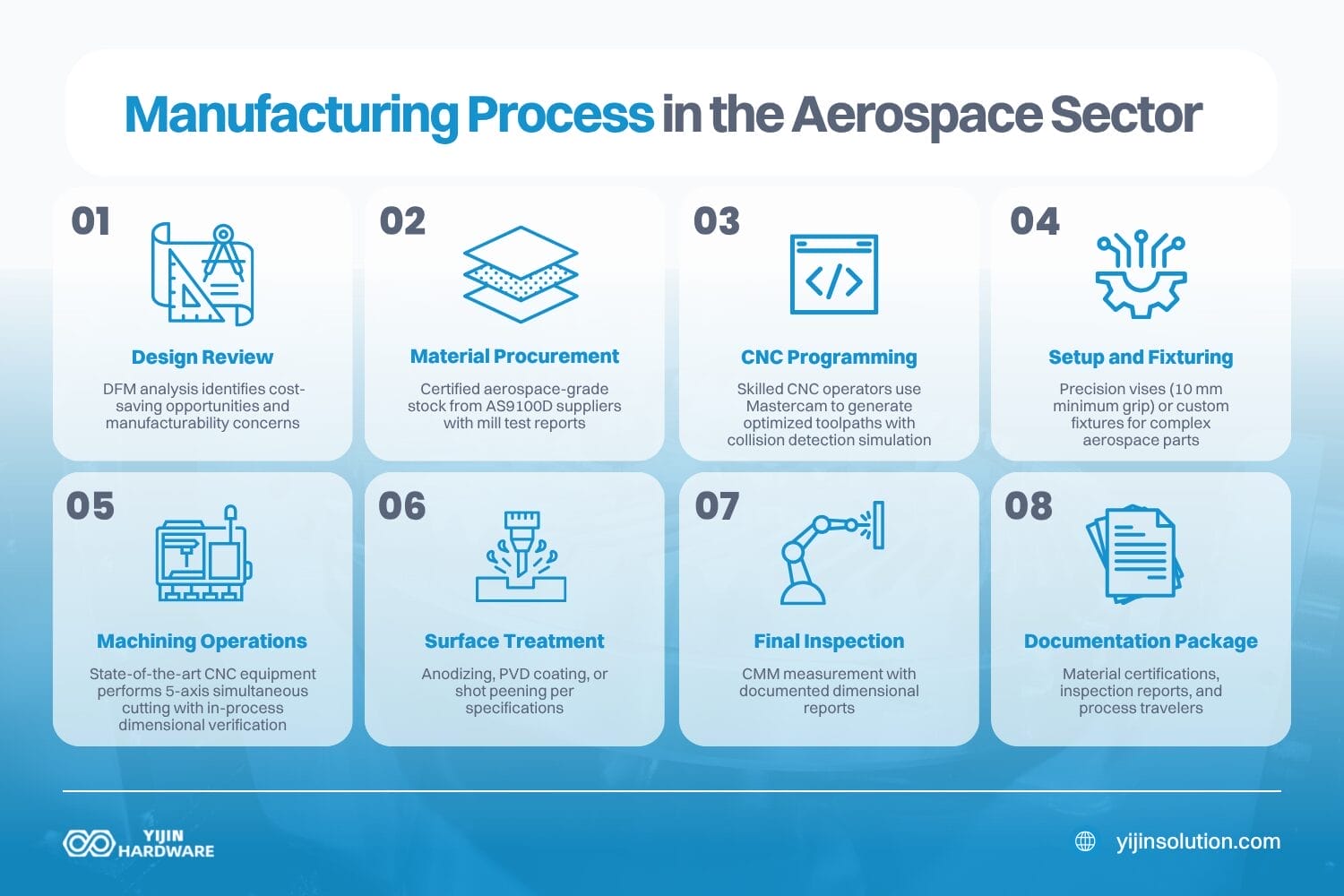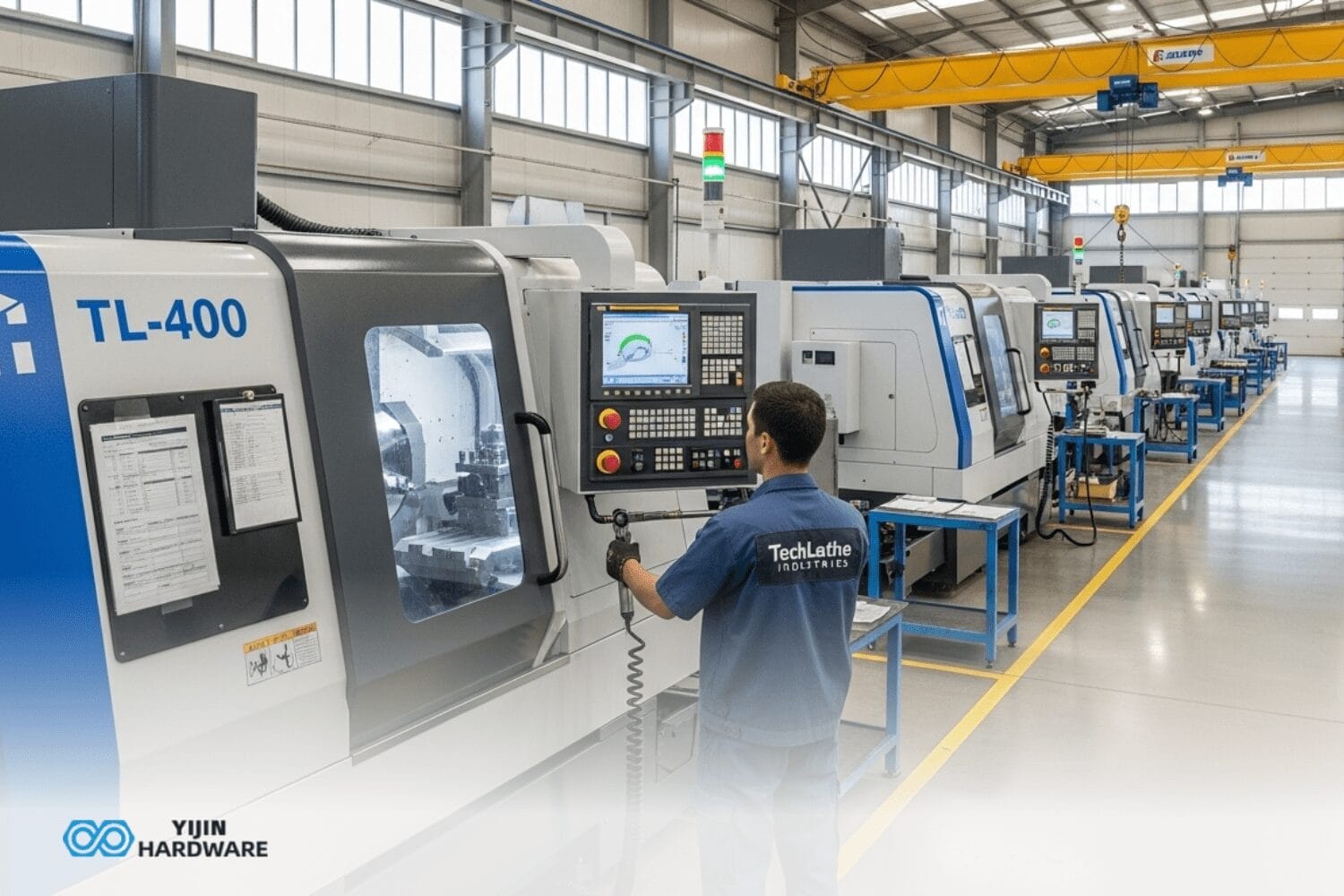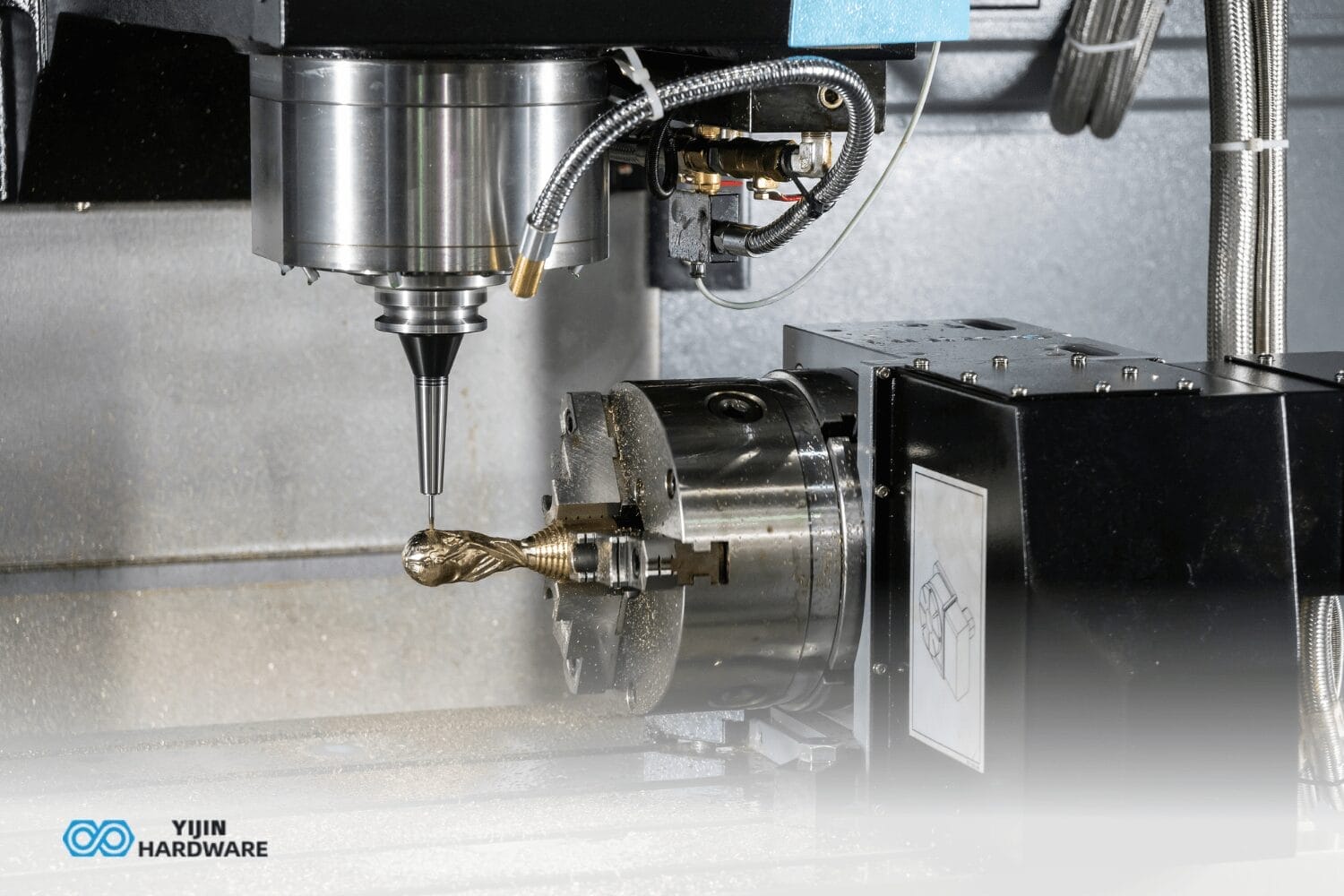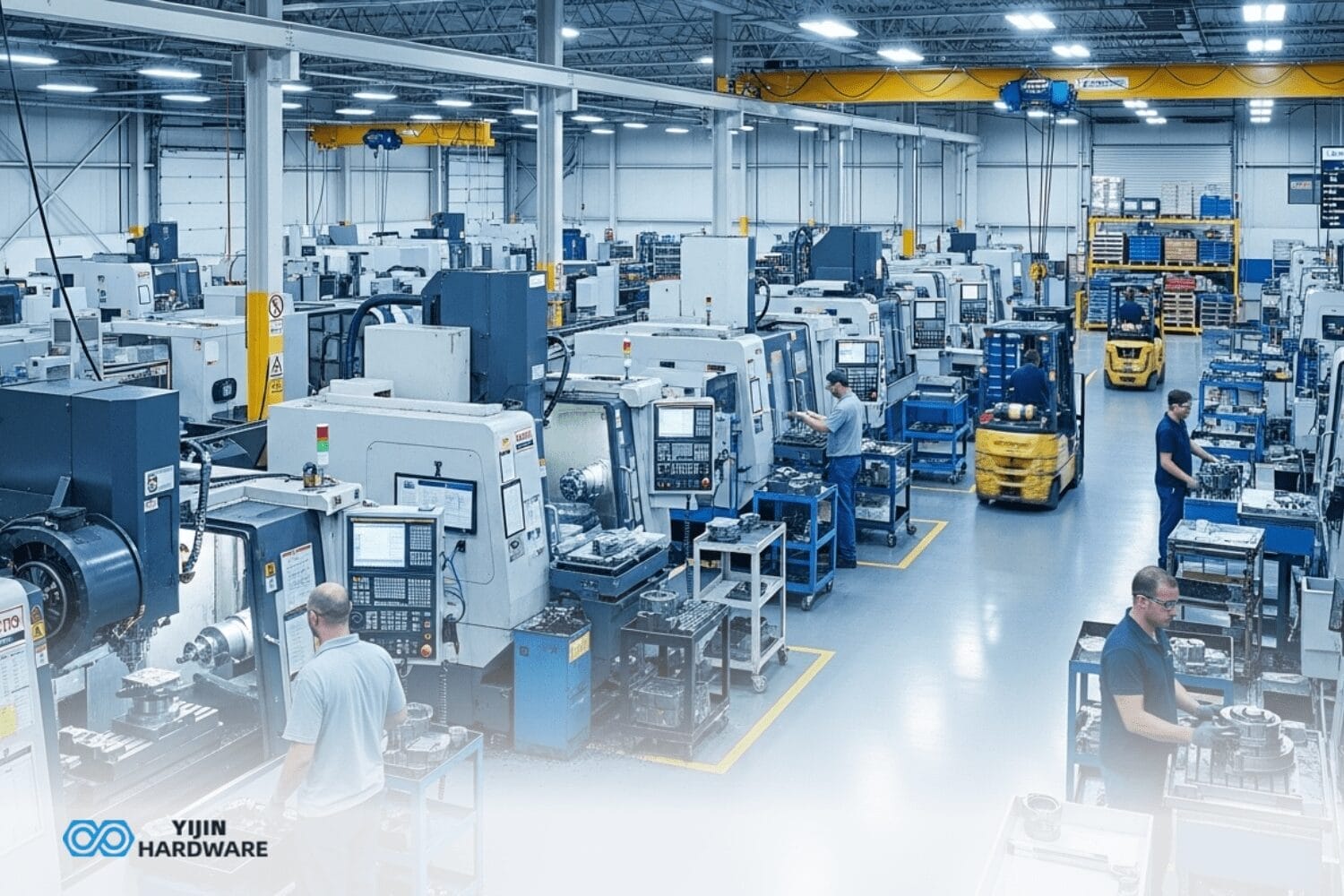Aerospace parts aren’t like regular manufacturing work – we’re talking about components that need tolerances within ±0.003″ (±0.076 mm) or tighter, complex shapes that require 5-axis simultaneous machining, and materials that have to handle temperatures over 2,000 °F without failing. Your average machine shop simply doesn’t have the certifications, equipment, or material knowledge to touch this kind of work, and honestly, they shouldn’t be trying.
We run AS9100D-certified operations with multi-axis CNC equipment specifically set up for aerospace demands. That means machining Ti-6Al-4V titanium, Inconel 718, and aerospace-grade aluminum alloys with full traceability and CMM inspection backing up every part. Whether you’re building aircraft or spacecraft components, the tolerances, material properties, and documentation requirements are non-negotiable – and that’s exactly what our setup is designed to deliver.
Key Takeaways
- AS9100D and ISO 9001 certifications mean the quality systems and traceability are actually there, not just claimed
- 5-axis simultaneous machining handles complex geometries in one setup, cutting lead times by 40-60% compared to multiple setups
- We actually know how to work with Ti-6Al-4V titanium, Inconel 718, and 7075 aluminum – complete with the material certs to prove it
- Tolerances hit ±0.003″ (±0.076 mm) or tighter, and every critical dimension gets verified through CMM inspection
- The equipment lineup includes 15 advanced CNC machines with 55″ Z-axis capacity for those bigger aerospace components
What is Aerospace CNC Machining?
Aerospace CNC machining is computer-controlled manufacturing that produces aerospace parts with tolerances between ±0.003″ and ±0.0001″ using multi-axis equipment. CNC (Computer Numerical Control) systems guide cutting tools through programmed toolpaths to remove material from titanium, aluminum, and superalloy blocks. This precision manufacturing process creates turbine blades, structural frames, landing gear components, and wing ribs for commercial aircraft, military jets, and spacecraft applications.
The aerospace industry requires tighter tolerances than automotive or industrial manufacturing because component failures can have catastrophic consequences. A turbine blade with improper dimensions creates imbalance at 20,000 RPM, potentially causing engine failure. AS9100D certification establishes the quality management framework for aerospace machining companies, extending ISO 9001 requirements with aerospace-specific controls for configuration management and complete material traceability. The latest insights show that Asia-Pacific is in control of the CNC machine market share, with over 55% in 2024.
Why is 5-Axis CNC Machining Essential for Aerospace Components?
CNC machining plays a crucial role in aerospace manufacturing because 5-axis capabilities allow cutting tools to approach workpieces from any angle by adding A-axis and B-axis rotation to standard X, Y, Z linear movement. This capability machines complex contoured surfaces like turbine blade airfoils in a single setup, eliminating tolerance stack-up from multiple operations. Aerospace manufacturers specify 5-axis machining for components with compound curves, undercuts, and thin-walled structures that cannot be accessed with 3-axis equipment.
3-Axis vs. 5-Axis Comparison
| Feature | 3-Axis Machining | 5-Axis Simultaneous |
|---|---|---|
| Setup Requirements | 4+ setups for complex parts | Single setup operation |
| Tolerance Achievement | ±0.005″ typical | ±0.003″ or tighter |
| Surface Finish | 63-125 Ra | 16-32 Ra |
| Production Time | Baseline | 40-60% faster |
Traditional 3-axis machining limits tool approach to perpendicular angles relative to the workpiece, requiring multiple setups to access different surfaces. Each setup introduces positioning errors that accumulate, potentially exceeding industry standards. The versatility of CNC machining with simultaneous five-axis movement creates superior surface finishes on sculptured geometries, preventing the gouging and faceting common with 3-axis step-over strategies.
What Aerospace Materials Can We CNC Machine?
We machine Ti-6Al-4V titanium, 7075 and 2024 aluminum alloys, Inconel 718 superalloy, and aerospace composites with complete material traceability documentation. Materials used in aerospace CNC machining require specialized cutting strategies, tooling, and parameters based on thermal conductivity, work hardening characteristics, and abrasiveness. Material selection depends on component requirements including strength-to-weight ratios, temperature resistance, and corrosion protection for aerospace applications.
| Material | Density | Temperature Resistance | Tensile Strength | Applications |
|---|---|---|---|---|
| Ti-6Al-4V Titanium | 4.43 g/cm³ | 1,000 °F (538 °C) | 130,000 psi | Engine components, landing gear |
| 7075 Aluminum | 2.81 g/cm³ | 300 °F (149 °C) | 83,000 psi | Wing structures, fuselage |
| Inconel 718 | 8.19 g/cm³ | 2,200 °F (1,204 °C) | 200,000 psi | Turbine blades, combustion chambers |
| 2024 Aluminum | 2.78 g/cm³ | 250 °F (121 °C) | 64,000 psi | Wing spars, aircraft interiors |
Titanium Alloy Machining
Ti-6Al-4V titanium offers a strength-to-weight ratio superior to steel at half the weight, making it essential for landing gear and engine mounts used in aerospace. This Grade 5 titanium alloy contains 6% aluminum and 4% vanadium, providing corrosion resistance in saltwater environments. We machine Ti-6Al-4V using carbide cutting tools at surface speeds of 50-150 SFM with high-pressure coolant to prevent work hardening.
Titanium’s low thermal conductivity concentrates heat at the cutting edge, accelerating tool wear. Through-spindle coolant systems deliver lubricant directly to the cutting zone at pressures exceeding 1,000 PSI, extending tool life significantly compared to flood coolant methods.
Aluminum Alloy Capabilities
7075 aluminum alloy provides the highest strength among aluminum grades, with T6 temper achieving 83,000 PSI tensile strength while maintaining a density of 2.81 g/cm³. This zinc-based alloy machines at surface speeds of 800-1,200 SFM, allowing rapid material removal for large fuselage components and wing structures in the global aerospace industry.
2024 aluminum alloy offers superior fatigue resistance over 7075, making it preferable for parts for aerospace experiencing cyclic loading, like wing spars and ribs. The copper content (3.8-4.9%) provides better crack propagation resistance, though tensile strength drops to 64,000 PSI in T4 temper.
Inconel Superalloy Processing
Inconel 718 maintains yield strength exceeding 150,000 PSI at 1,200 °F, essential for turbine blades exposed to combustion gas temperatures of 2,200 °F. This nickel-chromium superalloy contains niobium and molybdenum additions that form gamma-prime and gamma-double-prime precipitates, preventing dislocation movement at elevated temperatures crucial in aerospace operations.
CNC machining is employed to process Inconel 718 at conservative surface speeds of 30-60 SFM, with depths of cut limited to 0.040″ (1.02 mm) per pass. The material generates cutting forces 2.5 times greater than steel, demanding machines with 40 HP spindles and rigid construction.
What Tolerances Can Aerospace Precision Machining Achieve?
Precision CNC machining maintains standard tolerances of ±0.003″ (±0.076 mm) for general features, with critical aerospace dimensions achieving ±0.001″ (±0.025 mm) or tighter when specified. CMM (Coordinate Measuring Machine) inspection verifies dimensional accuracy with measurement uncertainty of ±0.0001″ (±0.0025 mm), ensuring aerospace components often meet exact design specifications. Statistical Process Control monitors dimensional trends during production, maintaining Cpk values above 1.33 for critical features as required by AS9100D quality standards.
Temperature Control Requirements
Temperature control proves essential for achieving aerospace tolerances because a 5 °F temperature change causes a 12″ (305 mm) aluminum component to expand 0.0008″ (0.02 mm). We maintain our machining facility at 68 °F ±2 °F (20 °C ±1 °C) with CMM inspection rooms held at 68 °F ±0.5 °F, ensuring that aerospace components receive accurate measurement. Components thermally stabilize for minimum 4 hours before final inspection.
Surface Finish Specifications
Surface finish specifications typically range from 125 Ra microinches for structural components to 16 Ra for aerodynamic surfaces. Our 5-axis finishing strategies employ ball-end mills with 0.002″ (0.051 mm) step-over distances, creating surface textures of 32 Ra or better without secondary grinding operations.
What Types of Aerospace CNC Machined Parts do We Produce?

We manufacture engine components including turbine blades with aerodynamic profiles, engine mounts, and combustion chamber parts requiring Inconel 718 for high-temperature resistance. Structural airframe components include wing ribs with complex contours, fuselage brackets, and reinforcement plates machined from 7075 aluminum. Landing gear components demand high-strength titanium alloys for load-bearing applications handling repeated stress cycles.
Engine System Parts
- Turbine blades with compound curve airfoils
- Engine mount structural supports
- Heat shield brackets for thermal protection
- Fuel system housings and manifolds
Structural Components
- Wing ribs optimized for airflow
- Fuselage brackets and fittings
- Structural frames and supports
- Landing gear actuator housings
Avionics Enclosures
- Sensor housings protecting electronic systems
- Control panel mounting brackets
- Interior cabin structural fittings
- Antenna mount assemblies
How does Our Aerospace Machining Process Work?
Our aerospace machining process begins with DFM (Design for Manufacturability) analysis within 24 hours of receiving CAD files in STEP, IGES, or Parasolid formats. Aerospace engineers review part geometry for potential issues like thin walls below 0.020″ (0.51 mm) thickness, sharp internal corners requiring specialized tooling, and features impossible to access with standard cutting tools.
Manufacturing Process in the Aerospace Sector

- Design Review: DFM analysis identifies cost-saving opportunities and manufacturability concerns
- Material Procurement: Certified aerospace-grade stock from AS9100D suppliers with mill test reports
- CNC Programming: Skilled CNC operators use Mastercam to generate optimized toolpaths with collision detection simulation
- Setup and Fixturing: Precision vises (10 mm minimum grip) or custom fixtures for complex aerospace parts
- Machining Operations: State-of-the-art CNC equipment performs 5-axis simultaneous cutting with in-process dimensional verification
- Surface Treatment: Anodizing, PVD coating, or shot peening per specifications
- Final Inspection: CMM measurement with documented dimensional reports
- Documentation Package: Material certifications, inspection reports, and process travelers
CNC machines can be pre-programmed to create functional models of aerospace parts and assemblies during prototyping phases. First article inspection establishes process baseline for new part numbers, documenting every dimension, material property, and surface finish measurement. Production parts undergo quality control in the aerospace manufacturing process per control plans specifying measurement frequency.
What Surface Treatments do We Offer?
CNC machining provides the foundation for surface treatments including anodizing per MIL-A-8625 creating 5-25 micron aluminum oxide layers, PVD coating applying 2-5 micron titanium nitride or chromium nitride for wear resistance, and shot peening per AMS 2430 inducing compressive stress layers. Surface treatments enhance corrosion protection, reduce friction coefficients, and increase fatigue strength depending on material and loading conditions.
Protective Treatments
Anodizing: Type II anodizing converts surface aluminum into Al₂O₃, harder than base material and accepting dyes for color-coding. Black anodize (MIL-A-8625 Type II Class 2) offers thermal emissivity benefits for heat dissipation components.
Passivation: Removes free iron from stainless steel components to prevent oxidation, maintaining corrosion resistance in harsh environments.
Performance Coatings
PVD Coating: Physical Vapor Deposition reduces friction coefficients from 0.4 to 0.15 while maintaining temperature stability to 900 °F (482 °C). Target materials vaporize in vacuum chambers and deposit at molecular level.
Shot Peening: Ceramic or steel media bombards surfaces at controlled velocities, inducing compressive stress opposing tensile stresses that initiate fatigue cracks. Landing gear components and engine mounts routinely receive shot peening.
What Certifications and Quality Standards Do We Maintain?
We maintain AS9100D certification through annual third-party audits conducted by accredited registrars, verifying compliance with aerospace quality management requirements. AS9100D extends ISO 9001 standards with aviation-specific controls for configuration management, first article inspection protocols, and complete material traceability from raw stock through finished components for the aerospace industry.
Quality Management System
- AS9100D: Aerospace quality standard with documented procedures for every manufacturing operation
- ISO 9001: Foundation for consistent quality output through management review cycles
- FAA Compliance: Documentation packages meeting Part 21 traceability standards
- EASA Awareness: Understanding of European aerospace regulatory requirements
Internal audits occur quarterly, examining procedure compliance and identifying improvement opportunities. Management reviews analyze quality metrics including on-time delivery rates, first-pass yield percentages, and customer complaint trends.
How does CNC Machining Unlock New Possibilities in Aerospace Manufacturing?
The integration of CNC machining with additive manufacturing processes enables aerospace companies to combine subtractive and additive techniques, creating hybrid components that unlock new possibilities in aerospace manufacturing. CNC machining is also used to finish 3D-printed aerospace parts, removing support structures and achieving final tolerances that additive processes alone cannot deliver.
Advanced aerospace machining techniques allow aerospace engineers to optimize designs previously impossible to manufacture. Using CNC multi-axis capabilities, we machine internal cooling channels in turbine blades, lightweight lattice structures in brackets, and complex contoured surfaces in one setup. CNC machining ensures precision and reliability across production volumes from prototype to high-volume runs.
The aerospace industry relies on CNC machining for rapid prototyping that accelerates development cycles. CNC machining helps aerospace project teams validate designs quickly, testing form, fit, and function before committing to tooling investments. Components for the aerospace industry can be made on the same machine during a single shift, reducing lead times from weeks to days.
Why Choose Yijin Hardware for Aerospace Machining Services?
We deliver AS9100D-certified precision with 15 advanced 5-axis CNC machining centers handling aerospace CNC parts up to 55″ (1,397 mm) in Z-axis capacity. Our climate-controlled 25,000 square foot facility maintains ±2 °F temperature stability, essential for achieving ±0.003″ tolerances on large aluminum airframe structures. Direct engineer collaboration eliminates sales intermediaries, allowing real-time design optimization discussions.
Our Competitive Advantages
- Equipment Capacity: 55″ Z-axis 5-axis mills with 20,000 RPM spindles and 40 HP drives
- Material Expertise: Ti-6Al-4V, Inconel 718, 7075/2024 aluminum with complete traceability
- Inspection Capability: CMM with 48″ × 60″ measurement volume and ±0.0001″ accuracy
- Quality Documentation: 100% dimensional inspection with Statistical Process Control monitoring
- Engineering Support: Free DFM analysis reducing manufacturing costs
We source materials exclusively from AS9100D-certified suppliers, maintaining mill test reports for every heat lot. Our programming team optimizes toolpaths specifically for aerospace alloys, balancing material removal rates against tool life to minimize production costs while maintaining surface finish requirements. CNC machining applications in our facility span from prototype development to production volumes exceeding thousands of units annually.
Ready to Start Your Aerospace Project?
The aerospace industry continues to demand higher precision, faster turnaround times, and more complex geometries. CNC machining offers the machining capabilities needed to meet these evolving demands while maintaining the precision and reliability aerospace systems require. Our AS9100D-certified facility, experienced aerospace engineers, and state-of-the-art CNC machining equipment position us to handle your most challenging aerospace machining requirements.
Contact Yijin Hardware today to discuss your aerospace CNC machined parts needs. Upload your CAD files for free DFM analysis and discover how our precision CNC machining services can optimize your aerospace manufacturing process while reducing costs and lead times.
Aerospace CNC Machining FAQs
How to become an aerospace machinist?
Becoming an aerospace machinist requires completing a technical diploma or certificate program in CNC machining, typically lasting 6–18 months at vocational schools or community colleges covering blueprint reading, precision measurement, G-code programming, and operation of 3-axis and 5-axis CNC equipment. Entry-level positions often start with 3-axis milling operations before skilled CNC operators advance to complex 5-axis aerospace work after gaining 2–3 years of experience, with NIMS (National Institute for Metalworking Skills) certifications demonstrating competency in specific machining techniques.
What is the main difference between CAD and CNC?
CAD (Computer-Aided Design) software creates digital 3D models and 2D drawings of parts, while CNC (Computer Numerical Control) machines physically manufacture those parts by removing material through programmed toolpaths. CAD systems like SolidWorks, CATIA, or Autodesk Inventor allow aerospace engineers to design component geometry and specify dimensions, while CNC machining is used to produce physical components by executing G-code instructions controlling spindle speeds, feed rates, and tool positions, with CAM (Computer-Aided Manufacturing) software bridging the two by converting design intent into manufacturing instructions.
What is the difference between ATC and CNC in aerospace?
ATC (Automatic Tool Changer) is a feature integrated into CNC machines that automatically swaps cutting tools during machining operations, while CNC (Computer Numerical Control) is the overall system controlling machine movements and processes. ATC systems hold 20–40 tools in carousel magazines, selecting and loading specific tools based on programmed commands without operator intervention, reducing cycle time and enabling lights-out manufacturing where machined parts are produced unattended overnight with tool length measurement probes that automatically compensate for tool wear.
Back to Top: Aerospace CNC Machining









